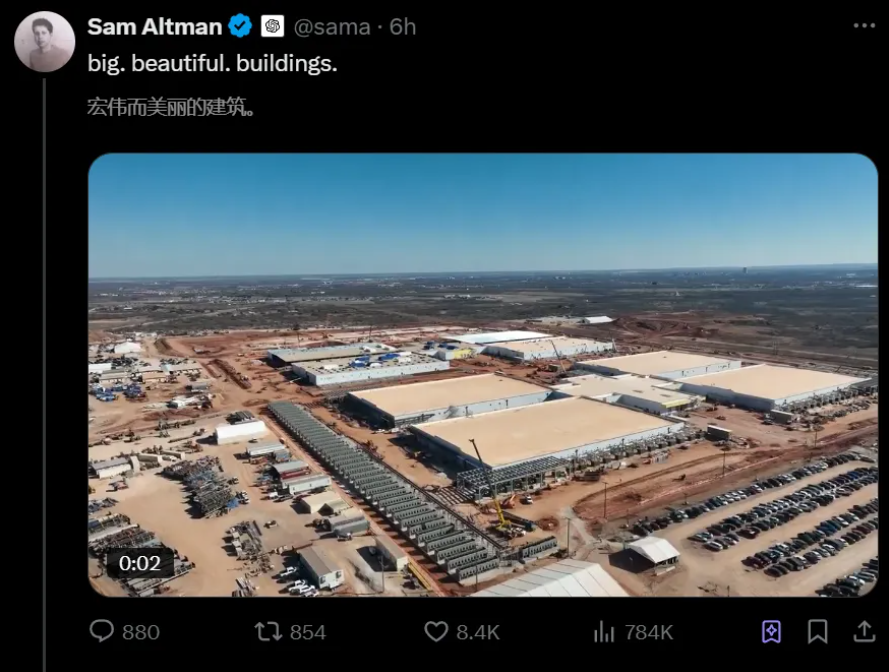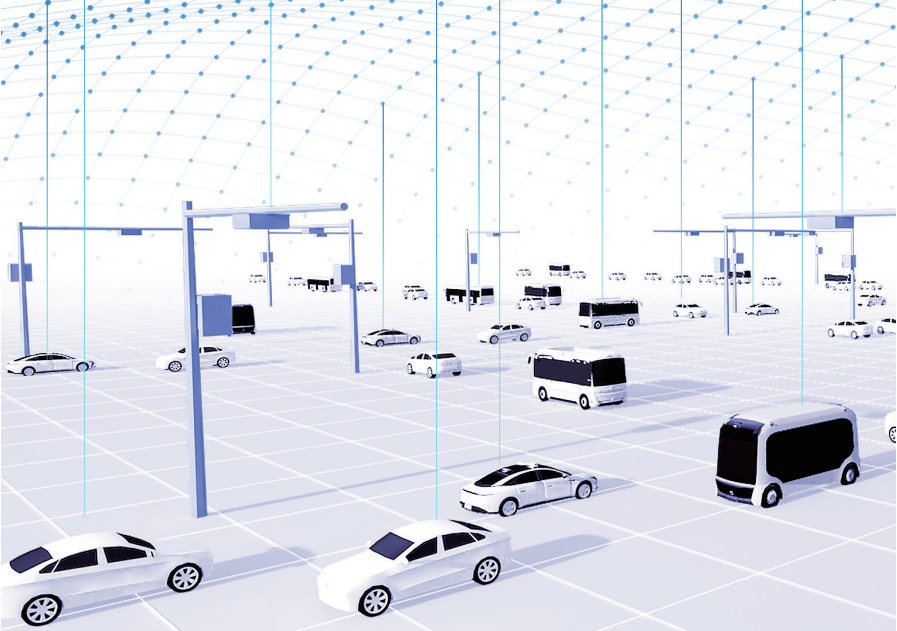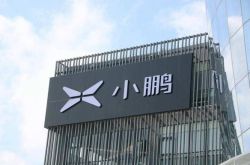OpenAI's StarGate Confronts Hurdles: China's 'Visible AI' Network Leads the Way
![]() 05/15 2025
05/15 2025
![]() 521
521
In May 2025, Sam Altman, the founder of OpenAI, donned a hard hat and stood before the construction site of the 'StarGate' supercomputing park in Abilene, Texas. Behind him loomed plans for 10 data centers. This colossal project, spanning 3.54 million square meters and designed to house 100,000 GB200 computing power clusters, is envisioned as the 'future totem' of US AI infrastructure. With OpenAI's launch of the 'OpenAI for Countries' program, aiming to replicate the 'StarGate' model globally with an initial investment of USD 500 billion, a subtle battle for infrastructure supremacy in the AI era is emerging between China and the US.

The US's 'StarGate': Strategic Anxiety Amidst Computing Power Frenzy
OpenAI's 'StarGate' initiative is fundamentally a race for computing power. According to the plan, the first park will become the 'world's largest AI training facility', aimed at supporting OpenAI's large model research and development, as well as global AI service delivery through centralized computing power clusters. Behind this plan lies the US's profound anxiety about the scarcity of AI infrastructure - despite having leading companies like OpenAI and Google, the US is feeling the pressure from China's rapid surge in AI computing power deployment and large-scale data center operations.
However, the US's infrastructure progress has not been without challenges. Centralized infrastructure models like 'StarGate' often face scrutiny over the 'input-output ratio'. Can a USD 500 billion investment translate into tangible productivity? While OpenAI is still outlining plans for 'customized ChatGPT' and 'national venture funds', China's AI network has already firmly established itself in transportation, manufacturing, urban management, and other sectors.
China's AI Network's 'Implementation Philosophy': From Intelligent Transportation to a Revolution in Sensing, Communication, and Computing Across All Industries
Unlike the US's 'computing power center' approach, China's AI infrastructure development has always been strongly 'application-oriented' from the outset. AI-powered intelligent connected vehicles, through the coordination of AI digital road base stations, lidar, and onboard sensors, can not only detect obstacles within 200 meters in real-time but also gain a 'global view' through large models: congestion predictions at upcoming intersections, detour suggestions for construction areas, and even pedestrian crossing intentions can be transmitted to the vehicle in real-time via the AI network.
This capability is underpinned by China's continuous promotion of the 'integration of vehicles, roads, and clouds' policy. Since the Ministry of Industry and Information Technology and other ministries launched pilot projects for the integration of vehicles, roads, and clouds, 20 pilot cities have completed the digital transformation of their roads. Unlike the US's 'teardown and rebuild' infrastructure model, China focuses more on 'activating existing resources' by upgrading the algorithms of existing roadside cameras, transforming devices that once only monitored road conditions into intelligent terminals capable of analyzing traffic flow and predicting accident risks in real-time. Meanwhile, comprehensive communication, sensing, and decision-making for the AI network are realized based on the 5G-A path. These two modes operate alternately, enabling intelligent agents to perceive, understand, and respond to the physical world in real-time, widely used in intelligent connected vehicles, driverless cars, low-altitude drones, robots, and other fields, empowering cities and managers. This 'low-cost reuse + efficient operation' model has already begun to take shape in China's AI network construction.

China-US Comparison: Comprehensive Differences in Policy Logic, Technical Paths, and Implementation Speed
Policy Logic: Strategic Focus vs. Capital Drive China's AI infrastructure development revolves around the 'new infrastructure' strategy, emphasizing collaboration between the government and enterprises. Covering the entire chain of 'construction - operation - data value mining', the government authorizes data operation rights, and enterprises activate data value through algorithm upgrades, which in turn feeds back service revenue to public services. In contrast, the US's 'StarGate' initiative relies more on capital forces - with investments led by companies like SoftBank and Oracle, aiming to swiftly roll out the computing power network through market-oriented operations. However, this model faces dual challenges of 'data sovereignty' and 'commercial returns': when OpenAI proposed that 'customized ChatGPT must follow US standards', many cooperating countries became skeptical.
Technical Path: Integration of Sensing, Communication, and Computing vs. Single Computing Power Center The core competitiveness of China's AI network lies in the deep integration of 'sensing, communication, and computing'. Large models based on the AI network can process vast amounts of roadside and vehicle-end data in real-time, not only providing 'over-the-horizon perception' for autonomous driving but also extending to scenarios such as industrial drone inspections and delivery robot scheduling in the future. The US's 'StarGate', on the other hand, focuses on centralized training of computing power, attempting to cover multiple scenarios through general large models. However, in fields requiring high real-time performance such as transportation and industry, its 'cloud training - terminal execution' model has inherent latency issues.
Implementation Speed: China's Rhythm from 'Pilot' to 'Scalability' By 2025, China had announced the list of the first batch of 20 pilot cities for the integration of vehicles, roads, and clouds. This is attributed to China's unique 'policy pilot - experience replication' mechanism: its 'old equipment reuse + 5G-A communication' solution will be swiftly promoted in other cities nationwide. In contrast, the first park of OpenAI's 'StarGate' is still under construction, and its global cooperation plan is constrained to 'US allies' due to geopolitical factors.
AI Network: Redefining the Boundaries of Human Interaction with the Physical World
While OpenAI is still deliberating over the business model of 'StarGate', China's AI network has already started reshaping industry logic. Artificial intelligence is transitioning from the digital world to the physical world, and the AI network will rely on smart traffic cameras, vehicle-road-cloud systems, and V2X communication in the future to collect city-wide traffic data in real-time, conduct intelligent analysis, and optimize decision-making, providing global perception and intelligent decision-making support for governments, automakers, and autonomous driving systems.
The essence of the AI network is to make the physical world 'perceptible, computable, and decision-makable.' The value of this capability transcends single computing power competition - it signifies that complex systems such as cities, factories, and transportation networks will possess 'cognitive abilities' akin to humans. For instance, when the AI network detects a collapse risk on a highway segment, it can not only immediately notify surrounding vehicles to detour but also simultaneously dispatch maintenance robots for operations, without any manual intervention throughout the process.
Visible AI is Rewriting the Rules of Global Technological Competition
From the wilds of Texas to the streets of Chinese cities, the disparity in AI infrastructure between China and the US is essentially a clash between 'laboratory thinking' and 'scenario thinking'. OpenAI's 'StarGate' embodies the US's pursuit of a 'universal AI utopia', while China's AI network development pragmatically integrates intelligence into every road and factory. While the US is still debating the location of computing power centers, China's AI network has become the 'digital nerve' of urban operations - this 'visible, tangible, and usable' technology implementation may be the core competitiveness of the AI era.





